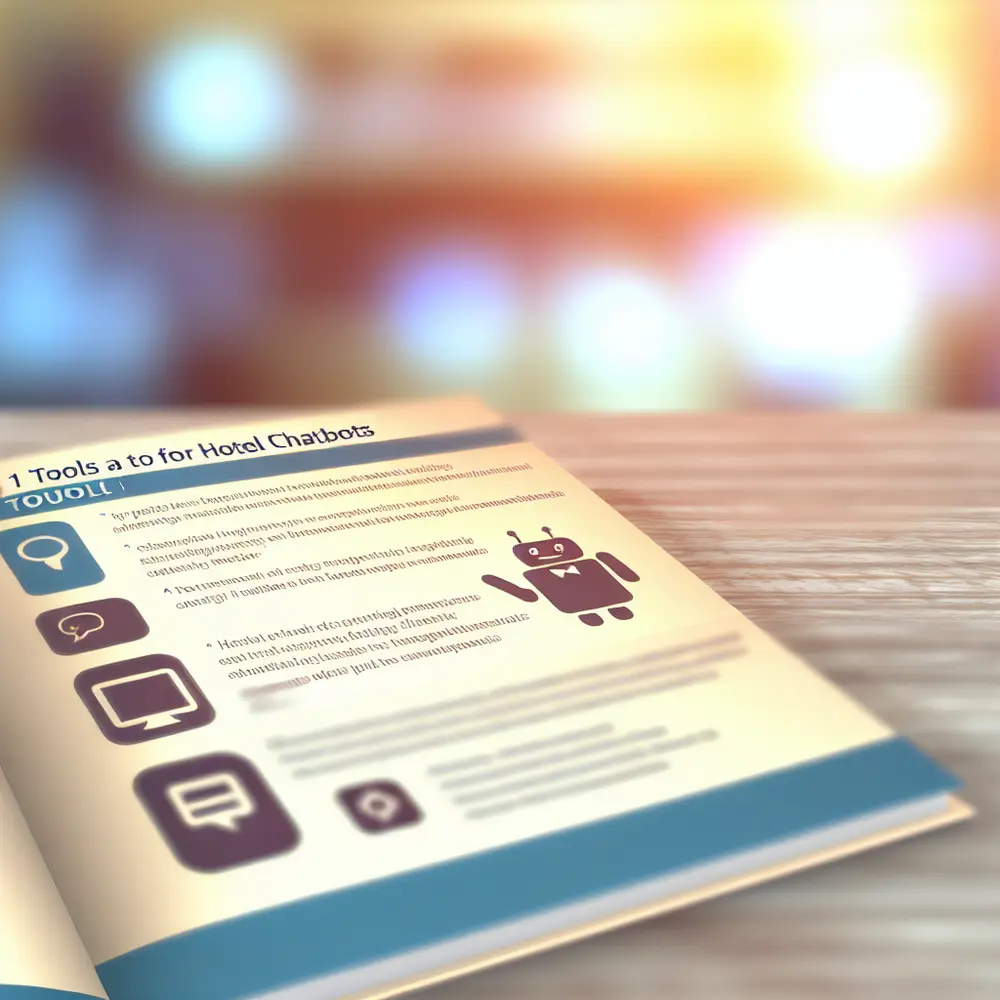In recent years, chatbots have emerged as a transformative technology in the hospitality industry, providing innovative solutions that enhance guest services and optimize existing operational processes. For hotels of all sizes, these AI-driven tools not only promise efficiency but also significantly improve customer satisfaction by offering instant responses and support. In this comprehensive guide, we will explore the myriad benefits of chatbot integration, how they can streamline operations, and the essential tools necessary for successful implementation.
As hotels continue to navigate the challenges posed by increasing customer expectations and the need for personalized services, chatbots present a timely opportunity to leverage technology for competitive advantage. From answering frequently asked questions to managing reservations, these digital assistants operate 24/7, ensuring guests receive assistance whenever they need it. This guide will delve into key functionalities, integration strategies, and effective chatbot management practices that are crucial for the success of your hotel’s automated guest interaction strategy.
Moreover, as we examine real-world applications and success stories, you’ll discover that tools available in the market can be tailored to suit small and medium-sized establishments, making this technology accessible and beneficial across the board. The following sections will take you through various aspects of chatbot implementation, helping you design a unique approach suited to your hotel’s specific needs while maximizing the overall guest experience.
Understanding Chatbots: What Are They and How Do They Work?
Chatbots are AI-powered systems designed to simulate conversations with human users, facilitating real-time interactions on various platforms. In the context of hotels, they provide essential support in managing inquiries, processing bookings, and providing personalized recommendations around the clock. This means that hotel guests no longer have to wait for office hours to get answers to their queries or assistance with reservations.
The end goal of incorporating a chatbot in the hospitality sector is to automate routine interactions, allowing staff to focus on more complex tasks that require a personal touch. By harnessing natural language processing (NLP) capabilities, modern chatbots can understand varied customer requests and respond in a relevant and helpful manner. This advancement significantly enhances user experience and fosters guest satisfaction.
For hotels considering the implementation of chatbots, it is essential to choose a platform that integrates well with existing management systems. This may include compatibility with property management systems (PMS) or customer relationship management (CRM) software, ensuring seamless data flow and accurate information exchange. By providing timely responses backed by real-time information, hotels can substantially boost guest loyalty and retention.
Why Your Hotel Needs a Chatbot: Key Benefits
The advantages of integrating chatbots into hotel operations are numerous and varied. Primarily, hotels can offer 24/7 support without increasing staffing costs. This not only improves guest satisfaction but also allows hotel staff to reallocate their efforts toward personalized guest interactions, enhancing overall service quality.
Additionally, chatbots can handle multiple conversations simultaneously, which is particularly beneficial during peak seasons or high-demand periods. By automating routine inquiries such as check-in/check-out times, room availability, and local attractions, hotels can significantly reduce wait times and improve operational efficiency.
Moreover, chatbots enable personalized interactions with guests by utilizing previous conversation data to provide tailored recommendations. This form of customer-centric service greatly enhances the guest experience and fosters loyalty. When guests feel that their individual needs are being attended to, they are more likely to return and recommend the hotel to others.
Step-by-Step Guide to Setting Up a Chatbot for Your Hotel
Implementing a chatbot in your hotel requires careful planning and execution. Start by identifying your hotel’s specific needs, such as common guest inquiries and essential services that can be automated. This foundational step ensures that the chatbot’s design aligns with your hotel’s objectives and guest expectations.
Next, select a chatbot platform that meets your needs. Popular choices like ManyChat, Drift, and Tidio provide customizable features tailored for hospitality while allowing integration with your existing systems. Evaluate the pros and cons of each option to determine which aligns best with your hotel’s operational workflow and budget constraints.
Once you have chosen a platform, develop conversation flows that reflect your established objectives. These flows should address common customer interactions, incorporating flexible language that resonates with guests. Testing the chatbot extensively before launch is crucial to ensure that it functions smoothly and provides accurate responses to guest inquiries.
Top 10 Chatbot Tools for Hotels: Features and Pricing
There are various chatbot tools available to suit the unique needs of different hotels. Tools like ManyChat excel in integrating with social media channels, allowing hotels to engage with potential guests directly on platforms they frequent. Tidio offers multi-channel support, ensuring that guests receive consistent service across various communication platforms.
Drift is ideal for driving engagement on your hotel’s website, helping qualify leads in real-time and connecting guests to your sales team when necessary. Meanwhile, Landbot allows hotels to build visually appealing and interactive chatbots through a drag-and-drop interface, making it highly customizable for branding purposes.
Pricing for these tools may vary significantly based on functionalities and features, ranging from free basic packages to paid premium options that offer advanced capabilities. A careful review of features and costs will help you choose the best tool that fits within your budget while delivering the desired outcomes.
Tips and Tricks to Maximize Your Hotel Chatbot’s Effectiveness
To ensure your chatbot is working effectively and providing value to guests, follow several best practices. Start by focusing on a user-friendly interface, allowing guests to navigate the chatbot seamlessly. Regularly update the chatbot’s knowledge base based on guest interactions to enhance relevancy and accuracy in responses.
Incorporate feedback mechanisms within the chatbot to gather insights from guests about their experiences. This information can inform further refinements and demonstrate your commitment to continuous improvement. Additionally, promote the chatbot through various channels, such as your website and email marketing campaigns, to encourage guest adoption.
Lastly, monitor performance metrics to gauge success and pinpoint areas for improvement. Analyze response times, customer satisfaction rates, and conversions to understand how well the chatbot meets guest needs. By staying proactive in its management, your hotel can significantly benefit from enhanced service delivery and guest satisfaction through chatbot integration.
Real-Life Examples: Successful Chatbot Implementations in Hotels
A number of hotels have successfully integrated chatbots into their customer service strategies, seeing tangible benefits. For instance, a boutique hotel chain used a chatbot to manage bookings and guest inquiries, resulting in a 30% reduction in response times and improved customer satisfaction ratings. By automating simple tasks, the staff could focus on more complex guest needs, leading to a more personalized and memorable experience.
Similarly, a luxury hotel implemented a chatbot that provided personalized recommendations for local attractions and dining options. Guests reported a more streamlined experience, as they could easily access information tailored to their interests, enhancing their overall stay. This approach not only increased guest satisfaction but also drove additional revenue through reservations at participating venues.
Common Challenges and How to Overcome Them When Using Chatbots
While chatbots offer numerous advantages, implementing them is not without challenges. One common issue hotels face is ensuring that the chatbot can understand and respond appropriately to a wide range of queries. To mitigate this, invest time in training the chatbot using diverse data sets that reflect real guest interactions.
Another challenge is integrating the chatbot with existing hotel management systems. Lack of compatibility can lead to data discrepancies and operational disruptions. Therefore, prioritize the selection of a chatbot that offers seamless integration with your existing PMS and CRM solutions to maintain consistency in communication and service delivery.
Finally, be prepared for instances where the chatbot may not be able to answer specific guest inquiries. Establishing fallback options that direct guests to human staff when the chatbot is unable to assist is crucial. This ensures that guests always have access to support, maintaining positive experiences even when the chatbot’s capabilities are tested.
Future Trends: The Evolution of Chatbots in the Hospitality Industry
The evolution of chatbots within the hospitality sector is poised to continue as technology advances. Future trends may include the integration of advanced AI systems capable of learning from interactions to provide increasingly personalized service. Enhanced natural language processing will allow chatbots to grasp context and tone, leading to more human-like interactions.
Additionally, as virtual and augmented reality technologies develop, there may be opportunities for chatbots to interact with guests in immersive environments, providing real-time assistance during their stay. Integration with smart devices in hotel rooms could see chatbots managing everything from temperature to entertainment options, paving the way for a truly connected experience.
Measuring Success: How to Track Your Hotel Chatbot Performance
To maximize the benefits of your hotel chatbot, it’s essential to track its performance through various metrics. Key performance indicators include response time, resolution rate, and guest satisfaction scores. Implementing analytics tools can help evaluate these metrics, providing insights into the chatbot’s effectiveness in enhancing customer service.
Regularly reviewing interaction data can highlight commonly asked questions and reveal opportunities for improvement. Establishing feedback channels will encourage guests to share their experiences, further informing optimization efforts. With a data-driven approach, hoteliers can continue refining their chatbots to better meet guest expectations.
Conclusion: Embracing Chatbots for a Competitive Edge in Hospitality
Integrating chatbots into hotel operations not only streamlines customer service but also enhances the guest experience significantly. By embracing this technology, hotels can remain competitive in an ever-evolving industry landscape. As we’ve explored throughout this guide, effectively implementing chatbots requires a strategic approach, from platform selection to continuous optimization.
Additionally, staying attuned to trends and continuously measuring performance will ensure that your chatbot evolves alongside guest expectations. Ultimately, the strategic use of chatbots will lead to increased operational efficiency, improved guest satisfaction, and higher revenues, establishing your hotel as a leader in the hospitality sector.









